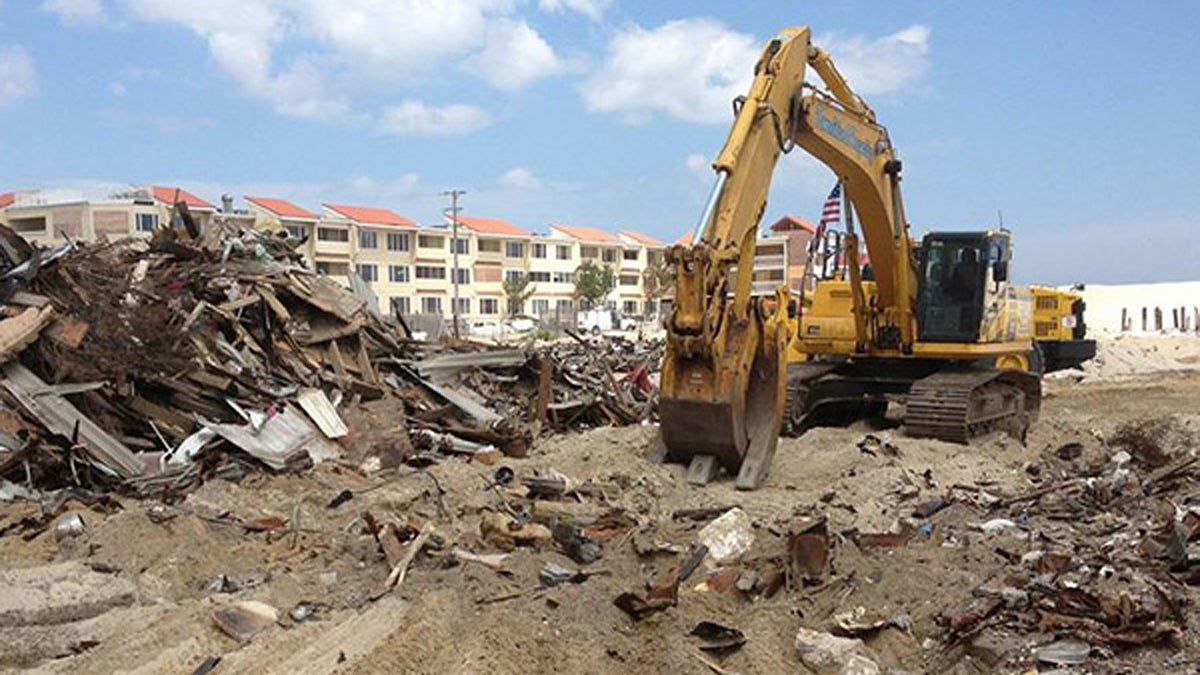In rush to restore the shore, is N.J. failing to plan for next superstorm?

(Photo courtesy of NJ Spotlight)
This is the first of a two-part series investigating the issues and controversies surrounding the different initiatives to help the Jersey Shore recover from the damage inflicted by Hurricane Sandy.
It was Tuesday evening, the day after Sandy made landfall, when a visibly exhausted Gov. Chris Christie stepped to the podium at state police headquarters in West Trenton, let out a sigh, and began the latest in a series of press briefings. The winds had finally died down, so he’d spent the afternoon touring the coast by helicopter, getting his first glimpse of the destruction.
He described seeing the boardwalk in Belmar that he had walked on just months before now completely gone. In Seaside Heights — which he called the Jersey Shore of his youth — the amusement pier where he took his kids the previous summer had partially collapsed into the ocean. And in front of the Governor’s Mansion at Island Beach State Park, he marveled at the incredible erosion of the coastline, with the beach almost totally washed away. Christie shook his head in utter disbelief and shrugged his shoulders.
“I just never thought I would see what I saw today . . . Ever”
Later that evening, he’d tell Fox News that the scene was “unthinkable,” and in the days to come, he’d use the word “unfathomable” to describe the extent of the damage. It was a common sentiment shared by thousands of residents up and down the coast, but according to multiple academic studies and government warnings, it shouldn’t have come as a complete surprise.
In the nearly nine months since Sandy made landfall, “Restore the Shore” has become the rallying cry for millions of New Jersey residents, eager to return life back to normal. But amid the rush to rebuild, the storm has raised a host of questions about planning and development patterns in the nation’s most densely populated state.
Many environmentalists and land-use experts warn that the coast was overbuilt to begin with, so they voice concerns about repeating the mistakes of the past by putting everything back where it was. Despite all the focus on rebuilding higher and stronger, they believe that having millions of people living at the water’s edge might be unsustainable in the long run. But coastal residents and business owners who’ve forged strong emotional and economic bonds to the region aren’t likely to pick up and move anytime soon.
The Dangers of Over Development
As far back as 1981, the state’s Department of Environmental Protection — in its New Jersey Shore Protection Master Plan — had warned of the dangers of coastal over-development and a repeat of the Ash Wednesday Storm of 1962, which killed fourteen people and wreaked havoc up and down the coast. “Since present population and development levels of the state’s barrier islands exceed pre-1962 levels, future severe storms will undoubtedly result in far heavier tolls in lives, injuries and property damage,” it said.
A 2005 Princeton University study examining the future impacts of sea level rise on New Jersey found “a significant lack of public understanding of the predictability of coastal hazards and hazard mitigation.
Episodic flooding events due to storm surges are often perceived as ‘natural disasters,’ not failures in land-use planning and building code requirements,” it stated, concluding that the best solution would ultimately be a “gradual withdrawal of development from some areas of the New Jersey coast.”
And in 2006, the DEP’s quadrennial Coastal Hazard Assessment Report to the federal government contained language calling for future development to be directed away from hazardous areas of the coastline. Among the impediments to achieving this goal, it noted, were the “lobbying efforts of special interest groups” and the “public perception that large-scale beach nourishment projects eliminate vulnerability to coastal hazards.”
— more —
WHYY is your source for fact-based, in-depth journalism and information. As a nonprofit organization, we rely on financial support from readers like you. Please give today.




